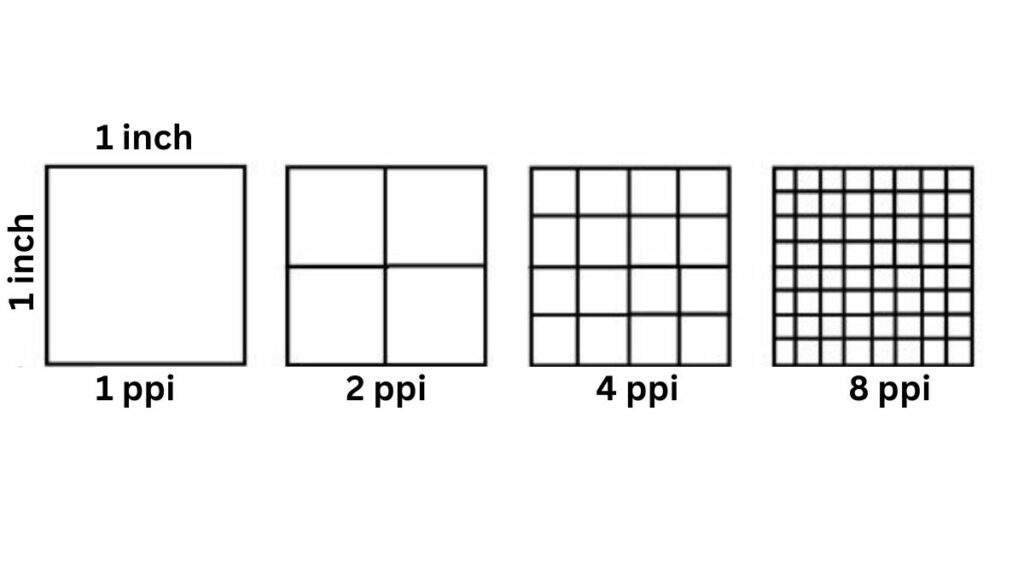Pixels are like tiny pieces in digital pictures and screens. They’re the smallest parts that show colors on your screen.
When you have more pixels in an image, it becomes clearer and more detailed. We call this ‘resolution,’ which tells us how sharp the image is.
What is Pixel?
Pixel is the smallest piece of information in an image, derived from “pix” (meaning “picture”) and “el” (meaning “element”).
It is a tiny square or dot representing a single point of color on a display screen. Pixels are the building blocks of digital images. They are used to create everything you see on a computer screen, whether a photograph, a video game, a web page, or any other form of digital content.
Each pixel contains information about its color, typically represented using a combination of red, green, and blue values (known as the RGB color model).
By varying the colors of individual pixels and arranging them in a grid, computers can display a wide range of images and graphics.

The Mechanism Behind Pixels
Pixels are like little workers that turn computer code into pictures on your screen. In color screens, each pixel gets a special code that tells it what color it is supposed to display.
Since each pixel has a red, green, and blue component (also known as RGB), the code is like a set of three numbers written in a special binary code language.
These numbers tell each part how brightly to shine; when they all shine together, they create the color you see. So, a pixel shows a color, and when you put a lot of pixels together, they make a picture.
What is a Megapixel?
Megapixels are basically a way of measuring how many tiny points (pixels) make up a digital photo. More megapixels usually means there is more detail in the photo.
If any photo has more megapixels, it means that the photo will have more clarity, and the photo quality will not be lost even after zooming in. A digital camera sensor with a 10-megapixel sensor has about 10 million or 10,00,000 pixels.
How many pixels are there in one megapixel?
The word “mega” means million. So, when we say a camera has 50 megapixels, it has 50 million pixels that it uses to capture pictures by capturing light.
What are Pixels in Computer Graphics?
A pixel in computer graphics is like a digital building block. It’s the smallest dot on a screen that can change color.
The amount, size, and colors of pixels change based on your graphics card and monitor. We measure this using something called ‘display resolution.’ For example, if your computer has a resolution of 1280 x 768, there are around 983,040 tiny dots on the screen.
What is Pixel Resolution?
Pixel resolution is the way we measure how sharp and clear images appear on the screen. This is the number of pixels in width and height, such as 1920×1080, which means there are 1,920 points horizontally on the screen and 1,080 points vertically.
What is Pixel Pitch?
Pixel pitch is like the space between dots on the screen. If there is a small pitch between the dots, then it means that the dots are close to each other.
If the dots are closer to each other, then we will see the pictures more clearly. And if there is too much gap (pitch) between the dots, we will not see the photo clearly.
Why Does Pixel Pitch Matter?
Pixel pitch is essential for image quality and clarity on a display. Smaller pixel pitch provides sharper visuals and higher resolution but can be expensive.
Selecting the correct pixel pitch depends on the viewing distance and specific application, ensuring the display effectively serves its intended purpose.
What is Pixel Size?
Pixel size refers to how big or small each tiny dot (pixel) is on your screen. Smaller pixel sizes often mean clearer pictures, higher resolutions, and the ability to have larger screens for the same level of detail. It’s about how much space each pixel takes up on your display.
Common Uses of Pixels
Image and video display:
Pixels are the building blocks of images and video on screens, including smartphones, computer monitors, TVs, and digital projectors.
Photography:
Digital cameras use pixels to capture and store images. A camera sensor’s number of pixels (megapixels) determines image quality and resolution. The more megapixels there are, the better the quality of the image.
Digital art:
Artists use pixels for illustration, animation, or graphic design.
Computer graphics:
Pixels are essential for rendering 2D and 3D graphics in computer-generated imagery (CGI) for video games, simulations, films, and animations.
Print media:
Pixels are important for determining printed materials’ quality and resolution, such as photos, posters, and magazines.
Text and font rendering:
Pixels play a role in rendering text and fonts on screens and printed materials, affecting readability.
Video surveillance:
Pixels are used in surveillance cameras to capture and analyze video footage for security and surveillance purposes.
Web Design:
Pixels are used in web design to create and lay out web pages, ensuring that content displays correctly on different devices and screen sizes.
Television broadcasting:
Pixels are used to transmit and display video content in television broadcasting.
What is Pixel Density?
Pixel density, or PPI (pixels per inch), measures how many pixels are packed into one inch of space on a screen or image. The more dots you have, the clearer things will appear.
Higher pixel density means more pixels are packed into the same area, resulting in a crisper and more detailed display or image.

Which range of Pixel Density is good?
A Class
Pixel density above 500ppi is the best, with incredibly sharp and vibrant image quality, making images look like they’re coming right off your screen. You can usually find this level of quality on flagship devices as they often have 1440p (QHD or 2K) or 2160p (UHD or 4K) displays.
B Class
Pixel density between 400ppi to 500ppi is good but falls short of A class in sharp and vibrant image quality. You find it in flagship killers, older flagships, and even new flagship models.
C Class
A pixel density between 300 and 400 ppi is ideal for a display. The colors look good in this range, the details are clear, and the overall image quality is satisfactory. Many midrange phones currently fall into this category, as they often feature 1080p resolution, which works well for larger screens above 6 inches.
D Class
Less than 300 PPI is average for pixel density, resulting in less accurate colors, reduced detail, and poorer image quality. This is especially noticeable with 720p resolutions on screens larger than 6 inches due to pixel spacing.
Difference Between Pixel Density and Resolution
Resolution is the total number of pixels on a screen, found by multiplying its width and height. For example, the resolution of an HD monitor is 1280×720 pixels, meaning it has a total of 921600 pixels.
While pixel density, often measured as PPI (pixels per inch), is the number of pixels in a given area, an inch usually means how many pixels are in a 1-inch area. Therefore, a higher PPI usually means better image quality because the pixels are harder to distinguish.
The pixel density of some common devices
| Devices | Screen Size (In inches) | Resolution(Pixels) | Pixel Density(PPI) |
|---|---|---|---|
| iPhone X | 5.8 | 2436 x 1125 | 458 |
| iPhone 11 | 6.1 | 1792 x 828 | 326 |
| iPhone 11 Pro | 5.8 | 2436 x 1125 | 458 |
| iPhone 11 Pro Max | 6.5 | 2688 x 1242 | 458 |
| iPhone 12 | 6.1 | 2532 x 1170 | 460 |
| iPhone 12 Pro | 6.1 | 2532 x 1170 | 460 |
| iPhone 12 Pro Max | 6.7 | 2778 x 1284 | 458 |
| iPhone 13 | 6.1 | 2532 x 1170 | 460 |
| iPhone 13 Pro | 6.1 | 2532 x 1170 | 460 |
| iPhone 13 Pro Max | 6.7 | 2778 x 1284 | 458 |
| iPhone 14 | 6.1 | 2556×1179 | 460 |
| iPhone 14 Pro | 6.1 | 2556×1179 | 460 |
| iPhone 14 Pro Max | 6.7 | 2796×1290 | 460 |
| iPhone 15 | 6.1 | 2556×1179 | 460 |
| iPhone 15 Pro | 6.1 | 2556×1179 | 460 |
| iPhone 15 Pro Max | 6.7 | 1290 x 2796 | 460 |
| Samsung Galaxy S10 | 6.1 | 3040 x 1440 | 550 |
| Samsung Galaxy S20 | 6.2 | 3200 x 1440 | 563 |
| Samsung Galaxy S21 | 6.2 | 2400 x 1080 | 424 |
| Samsung Galaxy S22 | 6.1 | 2340 x 1080 | 432 |
| 10-Inch Monitor | 10.0 | 1920 x 1200 | 224 |
| 20-Inch Monitor | 20.0 | 1920 x 1080 | 102 |
| 27-Inch Monitor | 27.0 | 2560 x 1440 | 108 |
| 30-Inch Monitor | 30 | 3840 x 2160 | 146 |
Final Word
Pixels may seem small, but they do big things in the digital world. They turn numbers into pictures that shape how we see things on screens.
Pixels do much work, from tiny phone icons to big, clear movie scenes.
Pixels are like quiet storytellers in a world where pictures say a lot. They make the images we see through cameras and on screens. So, when you look at a beautiful picture or watch a video, remember that pixels are the artists making it all happen in our digital world.



